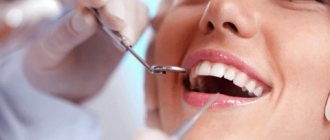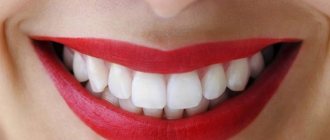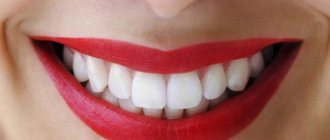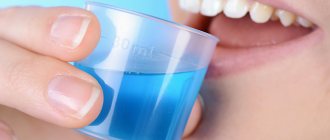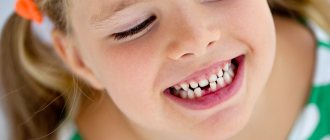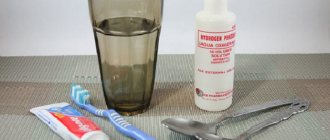What are the benefits of soda-salt solution for mouth rinsing?
The product is widely used for rinsing during the treatment of diseases of the teeth and gums: caries, gingivitis, periodontitis and periodontal disease. The solution helps out in cases where acute symptoms arise suddenly and you need to alleviate the condition before visiting the dentist. The soda-salt composition perfectly relieves inflammation and redness of the mucous membrane, disinfects, has a calming effect and helps to slightly reduce pain.
Sodium bicarbonate or simply soda is a product that is used to clean dirty surfaces, for example, in the kitchen. But a solution with its addition also helps in the treatment of many dental diseases. In combination with salt and sometimes with iodine, soda gives a pronounced antibacterial effect, strengthens hard and soft tissues, and prevents the further spread of the pathological process. Thus, the effect of the composition can be formulated in several main theses:
- has an antibacterial effect,
- helps stop the pathological process and prevents further destruction of the enamel,
- stops inflammatory processes in the mucous membrane,
- helps to significantly reduce pain and alleviate the condition,
- removes bacterial plaque and tartar.
Soda-saline solution helps in the treatment of many dental diseases.
Soda-saline solution is not suitable for daily use. It is recommended in cases where there are clear signs of pathological processes in the oral cavity. The composition can be used for emergency relief of acute symptoms, and as a maintenance agent - only after agreement with the attending physician.
Indications for use
It is better to use the composition for rinsing on the recommendation of a specialist - the treating dentist. The main indications for use are listed below:
- heavy plaque, supra- and subgingival deposits, unpleasant odor: the composition effectively fights bacteria in the oral cavity, dissolves hardening deposits and prevents the growth of pathogenic microflora. In addition, the active ingredients have a beneficial effect on the enamel and help strengthen it, and by cleaning surfaces from bacteria and their metabolic products, breath is freshened,
- severe toothache: it is not possible to cure the problem with just rinsing, but it is quite possible to significantly reduce the intensity of acute symptoms. The product will help normalize the condition so you can safely get to the doctor,
- after tooth extraction: preventive rinsing with a soda-salt solution will help fight bacteria, prevent wound infection, help stop bleeding and stimulate healing processes. You just need to rinse carefully so as not to damage the blood clot in the hole,
- diseases of the teeth and gums: rinsing with salt and soda is recommended, among other things, as maintenance therapy during the treatment of caries, gingivitis, periodontitis and periodontal disease, periodontitis and periostitis with purulent processes - according to indications and only in concentrations recommended by a specialist.
Rinsing helps in the treatment of inflammation of the gums and dental plaque.
If there are microtraumas or cuts in the mouth, which may appear, for example, due to braces or incorrectly installed fillings, crowns and dentures, then such a solution will help to effectively disinfect tissues, and its regular use will help their rapid healing.
Myths about teeth
Myths about teeth brushing and whitening
1. Teeth can be whitened with a special toothpaste. This is wrong . Bleaching pastes containing abrasive materials can only remove staining from nicotine or food. Such toothpastes will not be able to make teeth whiter than they were intended by nature. Real teeth whitening is done only in dental clinics , using hydrogen peroxide or carbamide peroxide compounds.
2. To make your teeth whiter, you need to brush them with baking soda. In fact, soda has a very high abrasiveness, much higher than permissible. Therefore, brushing your teeth with soda will cause it to scratch and eventually remove the enamel of your teeth . Soda is contraindicated for any type of periodontitis.
3. Brushing your teeth is generally harmful, as it wears away the enamel. If you do not brush your teeth , soft plaque forms on them , which first contributes to the development of caries , and then the formation of tartar.
4. Teeth need to be brushed only 2 times a day. It's minimum. The amount of brushing depends on the nature of the food, the amount of plaque and the general condition of the body.
5. Brushing your teeth should be done after breakfast. Yes, you really need to brush your teeth after eating. But in the morning it is better to brush your teeth before eating , immediately after waking up - this prevents the bacteria that formed in the oral cavity overnight from developing and prevents bacteria from entering the stomach during meals.
Myths about toothache
6. If you have a toothache, apply cotton wool with alcohol or crushed aspirin to the tooth. It is very dangerous. This will not make a sick tooth feel any better, but if held for a long time, it will burn the mouth.
7. For toothache, you need to apply garlic to your wrist. This is how a certain group of sectarians were treated. Their faith in this method helped them. You can try it too.
8. If your teeth don’t hurt, then you don’t need to go to the dentist. As a rule, diseases of the oral cavity initially occur painlessly . In addition, in the early stages the disease is much easier to cure. Therefore, you must visit the dentist twice a year.
9. Any visit to the dentist is scary and painful. This is wrong. Dentistry today means modern treatment methods, clinics are equipped with silent devices and a variety of painkillers.
Myths about bite correction and braces
10. You can correct your bite at any age. This is only true if one or two teeth need to be corrected . If the bite is disturbed due to the characteristics of the maxillofacial apparatus, then each specific case should be discussed with an orthodontist.
11. The bite should be corrected after replacing all baby teeth with molars. It is better to visit an orthodontist when the child is three years old. If a child sucks a finger or pacifier for a long time, it is better to visit an orthodontist before the age of three. This will prevent the development of malocclusions and premature removal of baby teeth.
12. Correcting a child’s bite is expensive. There is some truth. The services of an orthodontist are not cheap. But if we take into account that an incorrect bite leads to a violation of the chewing function, therefore, disorders of the gastrointestinal tract, diseases of the teeth and gums, then by correcting an incorrect bite as early as possible, it will be possible to get by with small losses of money.
13. It takes a long time to get used to braces. This is wrong. Getting used to it lasts one to two weeks. In the first days after installation, pressure is felt on the teeth. Subsequently, braces do not interfere even when playing wind instruments.
14. Braces damage tooth enamel. Between the bracket and the tooth there is a special material that releases fluoride and strengthens the enamel. Tooth enamel can be worsened by insufficient hygiene when wearing braces or eating foods prohibited by the orthodontist. It is necessary to follow all the doctor’s recommendations and take care of your teeth more carefully than before installing braces.
15. Wearing braces is not attractive. It is much uglier to have uneven teeth. And you can choose braces to suit every taste - silver, sapphire, ceramic, plastic, lingual.
Myths about prosthetics and implantation
16. When installing a crown on a tooth, the nerve must be removed. Not anymore. Modern technologies in dentistry make it possible to treat a tooth and prepare it for prosthetics without resorting to nerve removal. When processing a tooth, a minimal amount of its tissue is removed, and after grinding the tooth is coated with a special agent that reduces its sensitivity.
17. Gold never causes allergies in the oral cavity. It is a myth. Everything is very individual . Some people may experience inflammation where gold crowns touch the oral mucosa.
18. It is not at all necessary to place an implant if there is no tooth. On the contrary, it is very necessary. When a tooth is missing, the bone tissue of the jaw deteriorates , pits and cavities form, the load on the remaining teeth increases, but the quality of chewing suffers, and this is fraught with diseases of the gastrointestinal tract. Well, in the end, a person with a full row of teeth has a more aesthetic appearance.
Myths about tooth extraction
19. It is cheaper to remove a diseased tooth than to treat it. It depends on situation. If there are no direct indications for tooth extraction, it must be preserved and cured. The tooth extraction itself can indeed be much cheaper, but as we have already stated above, there should not be empty spaces in the mouth. But dental implantation will still cost more than treating your own tooth.
20. A diseased tooth must be treated until the last minute and under no circumstances should it be removed. Of course, tooth extraction is far from the best option, but a diseased tooth is a source of infection , which also adversely affects the health of the body. Everything is very individual. There are cases when a seemingly non-viable tooth can be cured, but a seemingly healthy tooth has to be removed.
21. After tooth extraction, the oral cavity must be thoroughly disinfected. This is true, but you must not overdo it so as not to wash the blood clot out of the wound. It helps in better healing. So it’s better not to touch this place for 2-3 days.
Myths about treating children
22. Any dentist, not necessarily a pediatric dentist, can treat a child’s teeth. Treatment methods for children's and adult teeth are different. This is due to the presence of baby teeth in children and the resorption of their roots. And it is the pediatric dentist who is more qualified to possess this information. In addition, the cost of pediatric dentistry is cheaper.
23. It is necessary for the child to be afraid of dentists, then he will take better care of his teeth. There is a chance that the child will brush his teeth well often, but psychological fear of dental treatment will be more of an enemy than a helper . Because you will still have to treat your teeth sooner or later in life. It is better to visit the dentist with your child 2 times a year so that he gets used to the fact that this procedure is not scary, but necessary.
24. There is no need to treat baby teeth; they will fall out anyway. This is a very harmful misconception for children's health. Untreated baby teeth lead to problems with molars. Extracted baby teeth disrupt the bite prematurely.
25. Sweets are bad for your teeth. Not all sweets. Chocolate, for example, contains cocoa beans, which have an antimicrobial effect and protect teeth from caries. But this does not mean that you should not brush your teeth after eating chocolate or consume it in moderation. It is better to drink carbonated drinks through a straw to reduce the contact of the liquid with the enamel of the teeth.
Other myths
26. Traumatic periodontitis can occur only after an injury (bruise, blow).
The most common causes of this disease are not injuries, but, for example, regular pressure on the teeth from the mouthpiece of a smoking pipe or musical instrument. It’s also a good idea to get rid of bad habits - biting threads, pressing on a tooth with a pencil or pen, shelling seeds, etc.
27. Trigeminal neuralgia occurs during a cold. No. Trigeminal neuralgia is viral in nature and manifests itself as herpetic rashes on the skin of the face, although a cold provokes this disease. The first thing to do at the first signs of neuralgia is to get rid of the virus, i.e. if the disease becomes chronic, a post-herpetic pain phenomenon may develop, and it will have to be treated with anticonvulsants.
When is it better to avoid rinsing - contraindications
If the recommended dosages are observed, the medicinal solution is completely harmless and safe. But in some pathological conditions and individual intolerance to its components, the use of the product is strictly contraindicated.
So, it is better not to add soda to the composition if a small child is going to rinse the mouth. Under the age of 3-4 years, a child can easily accidentally swallow the concentrated composition, and this is fraught with stomach problems. It is better to soak a cotton swab or a small piece of gauze in the solution, and then apply it to the sore spot for just a few minutes.
Do not use the rinse solution for children under 3-4 years of age.
You should not rinse your mouth with salt and soda if you have a traumatic brain injury, brain disease, or a predisposition to a stroke. In case of thyroid dysfunction, tuberculosis and nephritis, iodine1 should not be added to the main composition. The same applies to women during pregnancy and breastfeeding. Do not rinse too often if they provoke attacks of nausea.
How to prepare a universal soda-salt solution
To prepare the medicinal composition, you need to take a glass of boiled warm water - approximately 27-30 °C, and dilute a teaspoon of soda and salt in it. It is important to stir the bulk ingredients until completely dissolved. After this, you need to rinse your mouth thoroughly for 1-2 minutes, paying special attention to the sore area. By the way, the ingredients are good on their own. So, to relieve acute pain and symptoms of inflammation, you can rinse your mouth with only salt or only soda. In some cases, it is possible to add a few drops of iodine to enhance the effect.
Recipes
Salt and baking soda work well for pain relief and healing. To enhance the effect, you can use some other components. There are a number of recipes aimed at preventing disease and prevention in the oral cavity.
Antibacterial:
- chamomile decoction – 300 ml;
- soda – 5 g;
- salt – 5 gr.
The medicine is valid for 10 minutes after preparation.
Add the remaining ingredients to the chamomile liquid after it has cooled to 30-35 degrees. Anesthetic:
- sage and St. John's wort (3 g each) pour 300 ml. boiling water and let it brew for 20 minutes;
- soda – 5-7 g;
- salt – 10-12 gr.
The infusion needs to be strained and the remaining ingredients added to it. Instead of herbs, you can use essential oils, a few drops of each for the same amount of liquid. The action is no less effective.
Eliminates unpleasant odor
- warm water – 300 ml;
- soda – 10 g;
- salt – 6g;
- eucalyptus essential oil – 3 drops.
You can replace eucalyptus with an infusion of mint or rosemary, after brewing it. For 1 glass of liquid, use several fresh leaves, or 3-4 grams. dried.
Afterwards, strain the broth and add soda and salt to it. Brew rosemary with boiling water (5 g. 200 ml), let it brew for 30 minutes. Strain and mix with the remaining ingredients.
You should not use many herbs at the same time to prepare a decoction. Mixing will result in a strong aromatic effect and will cause discomfort in the mouth and negatively affect the smell receptors.
Anti-inflammatory:
- warm water – 250-300 ml;
- soda – 6 g;
- salt – 4 g;
- iodine – 3 drops.
The main thing is not to overdo it with iodine. Excessive consumption can cause burns and disruption of the thyroid gland.
How to use the product correctly
Before rinsing, be sure to brush your teeth. The temperature of the liquid should not exceed 30 °C - ideally it should be slightly warmer than room temperature. Too high a temperature can cause a burn, and cold can increase the pain. You need to use only freshly prepared solution, otherwise it will lose some of its properties. The product should not be swallowed; it must be spat out at the end of the procedure.
“I take out salt and soda only in extreme cases, when someone in the family has an acute inflammation, for example, gumboil. But you can’t use them every day, that’s for sure! A regular pharmaceutical product like Listerine or Colgate is sufficient for daily use. I deliberately take a little less liquid, because if you do it according to the instructions, sometimes it makes your teeth cramp. And a bottle is enough for our family for 2 weeks..."
Ulyasha, from correspondence on the woman.ru forum
If the pain is too severe, it is better to extend the procedure to 5 minutes. In this case, the liquid will have to be renewed every half a minute. It is important to understand that rinsing will help dull severe symptoms, but not cure the disease. Immediately after the condition returns to normal, you should urgently go to the doctor.
Rinsing will help dull severe symptoms, but will not cure the disease.
Rinse your mouth with saline solution
Salt has a pronounced antiseptic effect. It accelerates the healing of wounds and small cuts on the mucous membrane, and also prevents the growth of pathogenic microflora. In combination with soda, it effectively reduces inflammation, reduces the intensity of purulent processes, and helps to slightly reduce pain. The product is recommended for use on gums, mainly in cases of acute inflammatory processes accompanied by the release of pus - periodontitis, periostitis, etc.
The effectiveness of soda solution
Baking soda also relieves inflammation, but also has an antifungal effect. Due to its abrasive properties, the powder perfectly cleanses the enamel of bacterial plaque and other contaminants, helping to restore its natural shine and whiteness. In addition, soda disinfects tissues, reduces swelling and soreness. It is only important to follow the recommended proportions, otherwise you can easily burn the mucous membrane.
Remedy with soda and salt against pain and inflammation
With the development of dental diseases of an infectious nature, accompanied by acute symptoms, a mixture of soda and salt, diluted in boiled water in equal proportions, helps well. The product relieves toothache and prevents the further spread of the pathological process. The composition can be used as an emergency aid or as part of maintenance therapy after consultation with a specialist.
Soda-salt composition with added iodine
If you add a few drops of iodine to salt and soda, you can significantly enhance the effect of the drug. Iodine actively fights pathogenic microflora and prevents the proliferation of pathogens. All three components in combination with each other provide a pronounced analgesic effect and help reduce bleeding and swelling of soft tissues. You just need to be careful with iodine - you need to strictly adhere to the dosage and take into account possible contraindications.
Iodine actively fights pathogenic microflora
How to rinse correctly?
To achieve the desired result, not only proportions are important, but also knowledge of the rules for proper rinsing with a solution:
- Carry out procedures after brushing your teeth.
- After using the solution, do not rinse your mouth with plain water (for 10 minutes) and do not eat food (30 minutes).
- For severe diseases of the oral cavity, rinse every hour with a fresh solution.
- In case of increased bacterial growth, it is mandatory to carry out procedures before bedtime.
- Do not swallow used liquid.
- In terms of time, rinsing should take from 2 to 5 minutes each time.
- Use the solution only when warm. Hot water can cause burns, and cold water can cause sensitivity, damaging the enamel.
Simple rules that are not difficult to follow. The duration of such procedures until complete recovery takes from 5 to 10 days. After obtaining the desired result, you should still contact your dentist if this has not been done before.
Recommendations for preparing the product for different occasions
The solution is very easy to prepare, and the ingredients for it can be found in any home. Just keep in mind that the liquid needs to be prepared anew each time, and to dilute the components you should use warm boiled water or room temperature. Depending on the problem, recommendations for using the composition may be different - let's look at them in more detail.
When a toothache takes you by surprise
To relieve acute pain in teeth, it is recommended to dilute a teaspoon of salt in a glass of warm water. You can rinse your mouth every half hour until the intensity of the symptom subsides. You can add a teaspoon of soda to the main composition - then the effect will be more pronounced and come faster. Many also advise adding a couple of drops of iodine. On how to properly rinse a sore tooth, experts give the following recommendations:
- Before rinsing, you need to brush your teeth with a brush and toothpaste,
- the solution should be warm or at room temperature - if it is too cold or hot, the pain will only intensify,
- It is better to keep the liquid from the side of the causative tooth, focusing on treating the diseased area,
- There is no need to rinse your mouth with water after the procedure.
Rinsing is also used to relieve acute pain in the teeth.
As mentioned above, upon completion of the procedure, the liquid must be spat out. Each time the composition must be prepared anew, otherwise its effectiveness will significantly decrease.
If there are signs of acute inflammation in the soft tissues
To treat inflamed gums, the composition is recommended in the same proportions - about 200 ml of warm boiled water and a teaspoon of salt and soda. In this case, you can add a couple of drops of sage essential oil or a drop of iodine. Regular rinsing will help relieve swelling and soreness, reduce redness of the gums and strengthen the mucous tissue.
The composition can only be used in courses, and not on an ongoing basis, otherwise the effect may be reversed. The product will speed up the healing process if the mucous membrane hurts after tooth extraction. Only in this case, you shouldn’t rinse too intensely - you can simply hold the liquid behind your cheek on the side of the causative tooth.
While brushing your teeth for prevention
Sometimes salt and soda are recommended to be added to daily dental and oral care products. So, for example, in the composition of toothpaste, these ingredients enhance its abrasive and whitening properties. It is enough to squeeze a small amount of paste onto the brush, then take a little of the mixed powder and brush your teeth thoroughly for a minute.
Baking soda is also used when brushing teeth
Try not to touch your gums, and after completing the procedure, rinse your mouth with plain water. The mixture can be used in this way for a limited period of time. Otherwise, you can seriously injure the enamel, and this is fraught with the development of hyperesthesia and other unpleasant consequences.
Proportions
When preparing a rinse solution, you should be careful and maintain the required proportions, after consulting with your doctor:
- When bleeding from the gums or socket of a given organ, use 0.5 teaspoon of soda (6 grams) and 1 teaspoon of salt (10-12 grams) in 1 glass of warm water (35 degrees).
- For prevention, after brushing your teeth, add 7-10 grams to water (300 ml). components.
- For acute toothache, use 4 grams for the same amount of liquid. soda, salt twice as much. The effect is aimed at paralyzing the nerve ending of the organ, provoking a pain symptom with an antiseptic effect.
- Eliminate unpleasant odor from the cavity with a solution of 10 g. soda and 5 gr. salt per glass of liquid.
If your teeth are sensitive, you need to reduce the amount of salt by 1.5-2 times, as it provokes unpleasant sensations.
Can it be used during pregnancy?
Regarding the best way to rinse your mouth during pregnancy, you should definitely consult your dentist. It is not prohibited to use a soda-salt solution during this period, however, all precautions must be taken and if a pronounced gag reflex appears, stop the procedure immediately.
You also need to take into account that sometimes the combination of salt, soda and iodine gives an allergic reaction. Solutions with added iodine are generally not recommended during pregnancy. Do not exceed the dosage prescribed by the doctor so as not to provoke complications.
During pregnancy, you should be wary of any treatment methods.
Features of use in childhood
The composition can be given to children only from the age of 5. It is important that the child can already independently control the procedure, otherwise the baby may accidentally swallow the composition, and this is fraught with undesirable consequences for his stomach and digestive system. In addition, the components can leave burns on the mucous membrane.
For older children, the product is prepared according to the same principle, but in a lower concentration - half a teaspoon per glass of warm water. It is better to avoid iodine altogether - the effect of salt and soda is quite enough to relieve acute symptoms and disinfect tissues.
What are the pros and cons?
The main advantages are the availability of ingredients, ease of preparation, effectiveness and safety. Among the key advantages, experts highlight the following points:
- quickly relieves pain and inflammation,
- removes plaque and cleanses enamel, freshens breath,
- stimulates the healing of microtraumas and wounds on the mucous membrane,
- inhibits the formation of dental plaque,
- strengthens hard and soft tissues - the composition is useful for both teeth and gums,
- Easy to prepare from simple and affordable ingredients - a good budget option.
The disadvantages include unpleasant sensations due to enamel hyperesthesia, as well as a specific taste, which in rare cases causes attacks of nausea. In addition, the composition only relieves symptoms, but does not treat the disease itself, so its use is good before or after visiting a doctor, and then only as maintenance therapy.
- Borovsky E.V. Therapeutic dentistry, 2006.
What happens if you ignore warning signs?
If inflammation is not eliminated, over time the pathological process will destroy bone tissue, which will lead to loss of teeth. In addition, pus accumulated in soft tissues can enter the intermuscular space or subcutaneous area. This can lead to melting of nearby tissues, requiring the intervention of an oral and maxillofacial surgeon.
It is difficult to treat a prosthetic tooth; this will require unfilling the canals, conducting anti-inflammatory therapy, and filling the canals again. If the inflammation has affected the root apex, surgical intervention will be required - resection of the apex along with the granuloma or cyst.
The doctor decides how to relieve pain under the crown individually in each clinical situation, based on the cause, stage, and extent of inflammation. Sometimes the situation goes so far that the only effective treatment method is the removal of a tooth followed by prosthetics.
